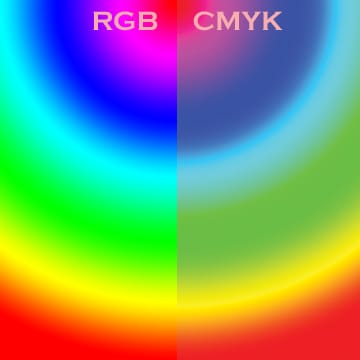RGB colour
The RGB colour model is an additive colour system in which Red, Green, and Blue light are added together in varying degrees to reproduce a broad array of colours. RGB is the basis of colours on computer screens and so is the system used in web design.
Eyes work on the basis of RGB; they have sensors for Red, Green and Blue.
CMYK colour
The CMYK model works by partially or entirely masking colours on a lighter, usually white, background. The letters stand for Cyan, Magenta, and Yellow. In theory, those three mixed together form black but it is more of a yucky grey, so a fourth colour is used, K, which is pure black. CMYK is the basis for colours in the print industry.
Printing ink, according to its colour, absorbs colours. The CMYK colour model is therefore called subtractive because inks subtract the colours red, green and blue from white light. White light minus red leaves cyan, white light minus green leaves magenta, and white light minus blue leaves yellow.
Thanks to Wikipedia for saving me from figuring out how to explain that!
The difference between RGB and CMYK in practice
The range of colour that CMYK can produce (the gamut) is much smaller than RGB colour gamut, so CMYK colours can look muted compared to RGB seen on a screen. Orange is an example. It always looks brighter and more vibrant on a screen than it does on paper. This is an important consideration in print production and demonstrates that for a print job, there is no substitute for a paper proof so that colours can be seen as they will actually be printed. When it is important that a colour looks as good as possible, a specially mixed ink can be used – a ‘spot’ colour – in addition to or instead of the four printing standards of CMYK.

